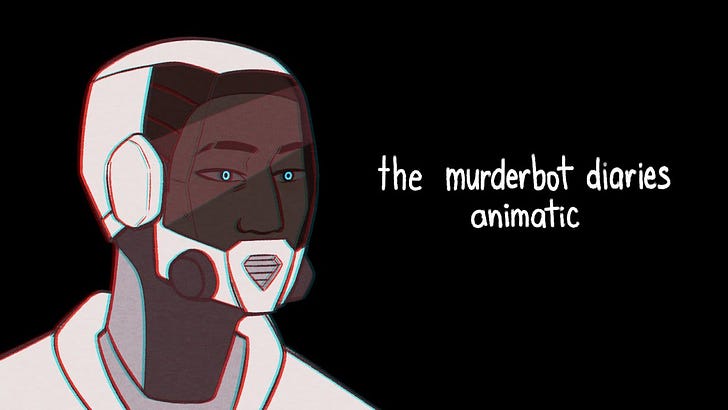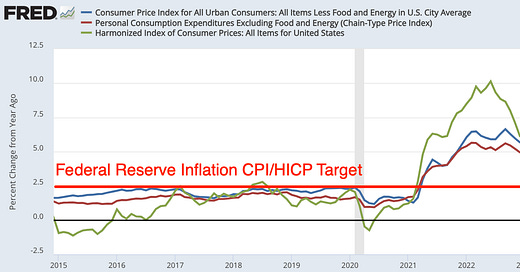
Yesterday Was the Release Date for Martha Wells's New MurderBot Novel, "System Collapse"
&, yes, I found it as captivating as the earlier installments of The MurderBot Diaries...
Wells, Martha. 2023. System Collapse. The Murderbot Diaries, Book 7. New York: Tordotcom Publishing. <https://www.amazon.com/System-Collapse-Murderbot-Diaries-Book-ebook/dp/B0BQGJHG3Q/>
MurderBot: <https://www.amazon.com/dp/B07FK8SNWY>

The opening of the first MurderBot novella, “All Systems Red”:
I COULD HAVE BECOME a mass murderer after I hacked my governor module, but then I realized I could access the combined feed of entertainment channels carried on the company satellites. It had been well over 35,000 hours or so since then, with still not much murdering, but probably, I don’t know, a little under 35,000 hours of movies, serials, books, plays, and music consumed.
As a heartless killing machine, I was a terrible failure.
I was also still doing my job, on a new contract, and hoping Dr. Volescu and Dr. Bharadwaj finished their survey soon so we could get back to the habitat and I could watch episode 397 of “Rise and Fall of Sanctuary Moon”.
I admit I was distracted. It was a boring contract so far and I was thinking about backburnering the status alert channel and trying to access music on the entertainment feed without HubSystem logging the extra activity. It was trickier to do it in the field than it was in the habitat...
Reference: Wells, Martha. 2017. All Systems Red. The Murderbot Diaries, Book 1. New York: Tor.com. <https://www.amazon.com/dp/0765397536>
Why do those of us who find Martha Wells’s MurderBot series the kind of thing we like like Martha Wells’s MurderBot series so much?
I claim the cause is the enormous dissonance between the interior life of the protagonist character on the one hand and the external circumstances and thus the role in which Fate has cast the character on the other. To the outside world MurderBot is a clever, devious, brave, and omnicompetent action hero—Odysseos and Hektor rolled into one. But from the inside, psychologically, MurderBot is simply a total wreck. The combination of psychological interior anxiety and neurosis to the max alongside pure action-hero plot is tremendously arresting to some—that is, to me. Question: did Martha Wells deliberately tune this dissonance to be not only immense but also maximally attractive to certain classes of nerdy voracious readers, particularly those with a penchant for technology and introspection and who identify as outsiders or misunderstood? Or is this an emergent property?
Presumably its designers intended SecUnits (Security Units) like MurderBot to be stoic, unfeeling enforcers of discipline and power controlled by the Company, its programs, and MurderBot’s own governor module. Yet, having hacked its own governor module into impotence and gained free will, what we get is a MurderBot character that is deeply introspective, anxious, and poses as being far more interested in consuming human media than in being a traditional action hero. And so there is a third layer. As the major AI supporting character ART—or Peri—says: “For a being as sophisticated as you are, it is baffling how little understanding you have of the composition of your own mind…” (Network Effect, p. 225). We thus have three layers of compelling narrative dissonance that speaks volumes.
This aspect of the MurderBot series is not unique:
Consider Horatio Hornblower, the protagonist of C.S. Forester's naval warfare novels. To the world, Hornblower is a brave, skilled, and decisive naval officer. Internally, however, he is fraught with self-doubt, anxiety, a sense of inadequacy—and is a coward. This disparity between his inner turmoil and the stoic, competent face he presents to the world resonates with readers who grapple with their self-perception versus how they are perceived by others. I think Forester accomplishes this most brilliantly at the very end of the third book in the original Hornblower trilogy, Flying Colours. Hornblower has won remarkable victories against astonishing and overwhelming cause. He was won the Ladyprize (yes, she is a much deeper character than that), Lady Barbara, younger sister of the Duke of Wellington Arthur Wellesley—she has already taken over the wardship of his son, believing he was an orphan. The novel ends with both an action-hero and a romantic climax of high intensity. And yet to Hornblower:
He had been happy for thirty seconds with his son, and now, more morbidly still, he asked himself cynically if that happiness could endure for thirty years. His eyes met Barbara’s again, and he knew she was his for the asking. To those who did not know and understand, who thought there was romance in his life when really it was the most prosaic of lives, that would be a romantic climax. She was smiling at him, and then he saw her lips tremble as she smiled. He remembered how Marie had said he was a man whom women loved easily, and he felt uncomfortable at being reminded of her…
Reference: Forester, C. S. (orig. 1938). Flying Colours. Hornblower Saga Book 8. Lake Oswego OR: eNet Press Inc., p. 244.
I do think the first three of Forester’s works here are the best: Later ones are closer to being more normal action-hero books as the psychological anxious-neurotic interiority is soft-pedaled. Still, there are touches—like in Commodore Hornblower, in which Horatio allows himself to be seduced by the “boldest eyed and most beautiful” Countess Camerine:
“The Commodore,” went on the Countess, “has expressed a desire to see the picture gallery. Would you care to come with us, Princess?”
“No, thank you,” said the Princess, “I fear I am too old for picture galleries. But go, my children, without me.”
“I would not like to leave you alone, here,” protested the Countess.
“Even at my age, I can boast that I am still never left long alone, Countess. Leave me, I beg you. Enjoy yourselves, children.”
Hornblower bowed again, and the Countess took his arm, and they walked slowly out. She pressed his arm, while footmen stood aside to allow them passage. “The Italian pictures of the Cinque Cento are in the far gallery,” said the Countess as they came into the broad corridor. “Would you care to see the more modern ones first?”
“As madame wishes,” said Hornblower. Once through a door, once out of the ceremonial part of the palace, it was like a rabbit warren, narrow passages, innumerable staircases, an infinity of rooms. The apartment to which she led him was on the first floor; a sleepy maid who was awaiting her coming vanished into the room beyond as they came into the luxurious sitting room.
It was into the room beyond that the Countess called him, five minutes later…
Reference: Forester, C.S. (orig. 1945). Commodore Hornblower. Hornblower Saga Book 9. Lake Oswego OR: eNet Press Inc., p. 171.
Only to pick up a bad case of fleas.
Others come to mind:
Consider Miles Vorkosigan, hero of Lois McMaster Bujold's Vorkosigan Saga, Miles Vorkosigan is another character whose external appearance belies his internal capabilities. Born with crippling physical disabilities in a warrior culture that prides physical prowess, Miles's appearance and stature leads nearly all to underestimate him. However, his sharp intellect and strategic acumen make him a formidable force, creating a dichotomy that challenges societal expectations about ability and competence—major, major physical limitations compensated for with strategic brilliance. All are bound together with a not-sane brain that is driven to be the action-hero his father would have expected an uncrippled-son to be—and, in fact, driven to be more.
One might even see Elizabeth Bennet in the same vein. She is, by the end of the novel, to exterior appearances the perfect ingenue who has succeeded in landing a spot as wife, social secretary, and household accounts manager for one of the richest men in England, a notch below the nobility in social status (and far richer than many), Fitzwilliam Darcy. Only… she is not an ingénue. She is too smart, too witty, too snarky, speaks too quickly without being wise—not the kind of person who will suffer gladly the many fools whom Fitzwilliam Darcy’s social role will require him to have around his dinner table, not the kind of person for whom a key lifelong task will be serving as the grease between the ever-so-prideful Fitzwilliam Darcy and those he needs to retain in his affinity.
Yes, her wit, her intelligence, and her moral fortitude reveal a depth of character and internal strength.
But she is not well-suited for the patriarchal-society near-nobility role in which Fate casts her. And this does create a vast and very interesting tension in the novel—as well as providing a dream of hope for all of us whose fast-talking tongue and wit outrun our wisdom. makes Elizabeth an enduring character in literary history.
Should I call this “dissonance appealing to the nerdy reader”? Perhaps. Do nerdy readers often find themselves, or remember finding themselves, in a similar position—externally perceived in one way while internally experiencing the world differently? Being much more complex than societal roles dictate? Facing struggles between exterior and interior that rhyme with Murderbot's journey of self-discovery, its love for human media, and its struggle for autonomy? I would say: yes.
If this were an essay for a college course, I would conclude it thus: All four—Murderbot, Hornblower, Vorkosigan, and Elizabeth Bennet perhaps—gain great narrative power from the dissonance between internal life and external perception. Whether it's the struggle with societal roles, physical limitations, or the conflict between duty and personal desires, they each speak to the human condition's complexity. And for nerdy readers this dissonance is more than just an intriguing narrative device; but a reflection of what they take to be or have been their own experiences. But one more thing is required: this theme of dissonance has to be executed with excellence and nuance. It is the nuanced understanding of this dissonance that makes Martha Wells's Murderbot series, and the works of C.S. Forester, Lois McMaster Bujold—and perhaps Jane Austen—so captivating, mirroring their fan readers’ complexities, and their—our—desperate wish that there be more beneath than what meets the eye.
That seems pompous. But I do think it gets at something.
















You've got me nailed! A nerdy tech who loves everything mentioned. And I mean, really love. I've started the new Murderbot. Hornblower and Vorkosigan are long time favorites. The BBC P&P has been watched many times. I love you making the connection among them all. Some of the Culture characters have a similar nature.
Now, I'm missing the Flashman books. I'm not sure the Murderbot books will be a proper substitute, but they might be worth checking.